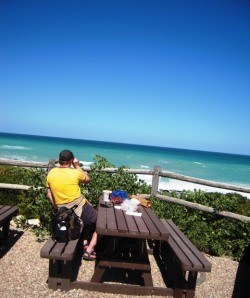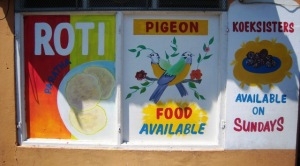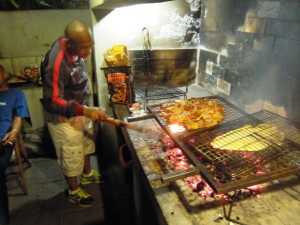Eating in the “Rainbow Nation”: South Africa
Posted: October 18, 2011 Filed under: Places, Politics 1 Comment
Table Mountain rises dramatically from the middle of Cape Town. This is a view from the colourful, (mostly) Muslim neighbourhood of Bo Kaap.
After a blogging hiatus, I’m sipping a steaming cup of Rooibos (red bush) tea on a cool English morning. I wasn’t a big fan of Rooibos until two weeks ago — when I sipped it at its source: South Africa. During the short trip, I greeted each day with a cup of the smoky red brew, and somehow it just tasted better there, especially while gazing up at Table Mountain, the centerpiece of Cape Town. I also found Rooibos yogurt, which has red flecks suspended in thick, honey-sweetened creaminess. I ate it in large quantities – because it tasted great, but also to care for my sensitive tummy, which isn’t nearly as adventurous as the rest of me when it comes to travel (let’s just say, Muhammad Ali’s wasn’t the only rumble in the jungle).
This short trip (for work and pleasure) was packed with food adventures. They ranged from an ultra-posh farmers markets serving ostrich breakfast burgers and kudu biltong (antelope jerky), to simple pap or samp (corn meal porridge) and beans at a place with a single table in the heart of Cape Town. There was fish on the braai (barbecue) with 20 members of the Port Elizabeth Wolves Football (i.e., soccer) Club seniors team, and fresh strawberries eaten while watching whales at De Hoop Nature Reserve. There were also koeksisters, syrupy sweet twisted donut strips, bought at the inaugural farmer’s market in Mossel Bay, to the background sounds of the Indian Ocean crashing into the rocky coastline. Nelson Mandela famously ate koeksisters during lunch with the widow of the architect of Apartheid, an unprecedented gesture of reconciliation in what is still – nearly two decades after the end of apartheid – a divided country.
Africa is a big country [sic]
I’ll share many of these adventures in future posts, but for now, I’ll just tell you about a food education I received while awaiting some (delectable) chicken and pap (cornmeal porridge, served in a lump that looks like a cloud) at a humble place called Yoggata Mini Kitchen. This was the place with one table, tucked away behind a women’s craft market on Long Street. Outside the market was a small sandwich board advertising foods we didn’t recognize, but which sounded like traditional African food … or at least our idea of African food.
In truth, we had no idea because we’d never been to Africa before (except north of the Sahara), and were relying on advice from our guide book and our imaginations, influenced by films and books. And of course … Africa is a really big place. Any notion we had of ‘African food’ was bound to be dashed by the diversity of the continent, not to mention South Africa’s unique status in Africa: it has the continent’s largest economy and the largest communities of people of European and Asian descent. Plus, Cape Town was first settled by Europeans in the 1600s, so it shouldn’t have been surprising that modern European fare was on offer everywhere we looked, including sandwiches and salads, pizzas and burgers, pastas and even a Mexican cantina serving cheap tequila shots.
Pap my ride

The communal table at Yoggata Mini Kitchen, Long Street, Cape Town (behind the African Women's Craft Market)
Despite the realization that modern South African cuisine did not coincide with my romantic daydreams about ‘Africa’ (which were largely influenced by the soft-rock stylings of Toto and the movie ‘Gorillas in the Mist’ … neither of which has anything to do with South Africa), I was still keen to try something new. So when we came across the sign for Yoggata Mini Kitchen, we were intrigued. We walked through the colourful stalls packed with crafts and dangling with beaded jewelry, all the way to the back, where we found a dozen shops constructed from largely unadorned white walls, lighted by brash fluorescent bulbs, and mostly without signs to tell us what they were offering.
The barber trimming a man’s hair in the first shop was obvious, and we guessed that the next shop was serving food as we saw people walking out with wrapped bundles. Next was a place staffed by Rastafarians printing t-shirts, and finally our destination: Yoggata Mini Kitchen. It was decorated with brightly-coloured curtains and table settings, complemented by a warm greeting from the owner Phyllis Melane. She offered help understanding the menu, and then invited us to take a seat at the single plastic table. We had pap and fried chicken (with crispy, well-seasoned skin that I couldn’t get enough of), samp and beans, and curried vegetables. It cost about GBP4 ($6) for two filling meals.
It was so good we returned the next day. This time we were joined at the communal table by a couple from the Caribbean, who were in South Africa visiting their nephew. The nephew (a lecturer at the local university) sat down next to us. Just before tucking into his steaming plate of lamb stew and pap, he reiterated something I’d read: that Cape Town, among all of South Africa’s cities, is the least integrated, with black, white and coloured (mixed-race) people still inhabiting their own milieus to a large extent. And this extends to its food culture or, more accurately, its food cultures.
So the ‘traditional’ local food you can find in Cape Town and around might be African, like what we were eating at Yogatta; it might be ‘settler’ – mostly Dutch and British, but also German; or it could be Cape Malay, which largely came from the Indonesian or Javan slaves brought to Cape Town hundreds of years ago by the Dutch East India Company. Cape Malay includes South Asian foods (which we might think of in the US as ‘Indian’), such as samosas (samoosas) and curries. And of course, today there is the smattering of other non-traditional cuisines you’d see in any modern city in the world: Chinese, Thai, Japanese, Portuguese (we were rarely far from a Nandos chain restaurant), Spanish and many more.
Cape Town’s food cultures
The huge range of what could be considered local and traditional food in Cape Town made me aware of how little I know about this country, which is often called the “Rainbow Nation” because of its diversity. I don’t think I’m the only person who, if asked what I knew about South Africa, would only have been able to conjure up information about Nelson Mandela and apartheid, or about the dreadful crime statistics that so often characterize stories about South Africa today. When it comes to food, I would have drawn a complete blank, except with regard to red bush tea and wine (and even then I knew next to nothing, only that they produce these things).
Now I’m only slightly wiser about South Africa’s food cultures, but more specifically the food of Cape Town and around, since it varies by region, and one look at a map showed me just how little of the country I’d seen.
Despite this, I’m happily savouring the memories of the meals I had and, importantly, the people I met while eating them. It’s this latter point which seems most telling of eating in South Africa, as in all countries – that food is something social, to be shared. For example, the braai, which is translated as ‘barbecue’, has a social significance and set of traditions unique to the region, and unlike what I know of barbecues in the US and UK (but slighly more similar to barbecues in Australia). And while eating my last portion of pap at Marco’s – an upscale pan-African restaurant – the Durban-born woman beside me informed me that pap is meant to be eaten with your hands from a plate shared among family and friends. Upon hearing this, the American woman sitting opposite set down her fork, picked up a chunk of pap with her fingers, used it to scoop up some meat and popped it in her mouth. With that gesture, we all smiled and continued feasting on ostrich, kudu and springbok (gazelle) cooked rare, washed down with a glass of local Cabernet-Merlot. While divisions still exist in South Africa, it’s nice to experience a coming-together around a great meal.
More South African adventures to come in future posts…






Golly, Africa is a big country (sic)! I was amazed at the diversity you described. Can’t wait for more. Sending you love!